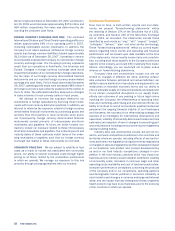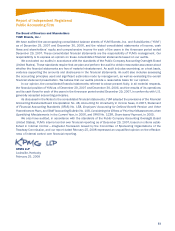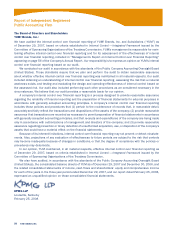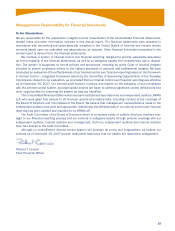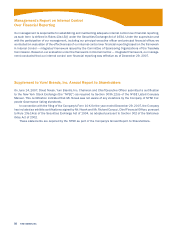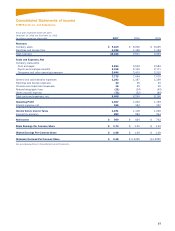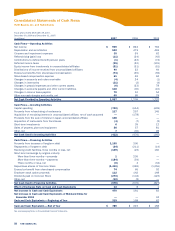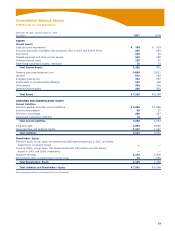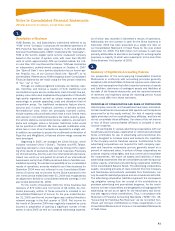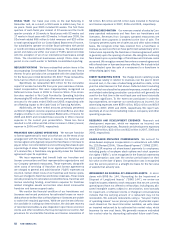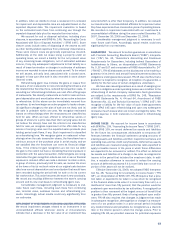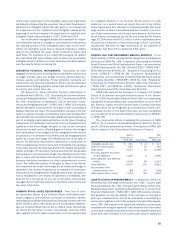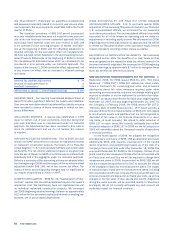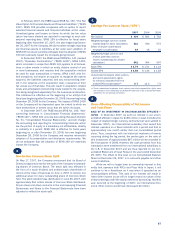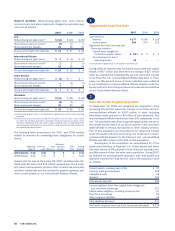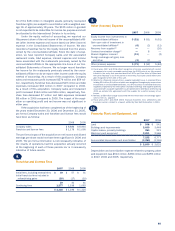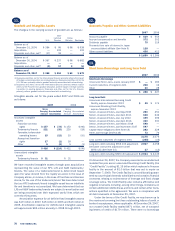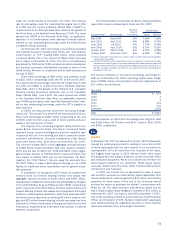Pizza Hut 2007 Annual Report Download - page 57
Download and view the complete annual report
Please find page 57 of the 2007 Pizza Hut annual report below. You can navigate through the pages in the report by either clicking on the pages listed below, or by using the keyword search tool below to find specific information within the annual report.
61
Notes to Consolidated Financial Statements
(Tabular amounts in millions, except share data)
all of which was recorded in December’s results of operations.
Additionally, the net increase in cash for the China business in
December 2004 has been presented as a single line item on
our Consolidated Statement of Cash Flows for the year ended
December 31, 2005. The $34 million net increase in cash was
primarily attributable to short-term borrowings for working capital
purposes, a majority of which were repaid prior to the end of the
China business’ first quarter of 2005.
2.
Summary of Significant Accounting Policies
Our preparation of the accompanying Consolidated Financial
Statements in conformity with accounting principles generally
accepted in the United States of America requires us to make esti-
mates and assumptions that affect reported amounts of assets
and liabilities, disclosure of contingent assets and liabilities at
the date of the financial statements, and the reported amounts
of revenues and expenses during the reporting period. Actual
results could differ from these estimates.
PRINCIPLES OF CONSOLIDATION AND BASIS OF PREPARATION
Intercompany accounts and transactions have been eliminated.
Certain investments in businesses that operate our Concepts are
accounted for by the equity method. Our lack of majority voting
rights precludes us from controlling these affiliates, and thus we
do not consolidate these affiliates. Our share of the net income
or loss of those unconsolidated affiliates is included in other
(income) expense.
We participate in various advertising cooperatives with our
franchisees and licensees established to collect and administer
funds contributed for use in advertising and promotional pro-
grams designed to increase sales and enhance the reputation
of the Company and its franchise owners. Contributions to the
advertising cooperatives are required for both company oper-
ated and franchise restaurants and are generally based on a
percent of restaurant sales. In certain of these cooperatives we
possess majority voting rights, and thus control and consolidate
the cooperatives. We report all assets and liabilities of these
advertising cooperatives that we consolidate as advertising coop-
erative assets, restricted and advertising cooperative liabilities
in the Consolidated Balance Sheet. The advertising cooperatives
assets, consisting primarily of cash received from the Company
and franchisees and accounts receivable from franchisees, can
only be used for selected purposes and are considered restricted.
The advertising cooperative liabilities represent the correspond-
ing obligation arising from the receipt of the contributions to
purchase advertising and promotional programs. As the contri-
butions to these cooperatives are designated and segregated for
advertising, we act as an agent for the franchisees and licens-
ees with regard to these contributions. Thus, in accordance with
Statement of Financial Accounting Standards (“SFAS”) No. 45,
“Accounting for Franchise Fee Revenue,” we do not reflect fran-
chisee and licensee contributions to these cooperatives in our
Consolidated Statements of Income or Consolidated Statements
of Cash Flows.
1.
Description of Business
YUM! Brands, Inc. and Subsidiaries (collectively referred to as
“YUM” or the “Company”) comprises the worldwide operations of
KFC, Pizza Hut, Taco Bell, Long John Silver’s (“LJS”) and A&W All-
American Food Restaurants (“A&W”) (collectively the “Concepts”).
YUM is the world’s largest quick service restaurant company
based on the number of system units, with more than 35,000
units of which approximately 44% are located outside the U.S.
in more than 100 countries and territories. YUM was created as
an independent, publicly-owned company on October 6, 1997
(the “Spin-off Date”) via a tax-free distribution by our former par-
ent, PepsiCo, Inc., of our Common Stock (the “Spin-off”) to its
shareholders. References to YUM throughout these Consolidated
Financial Statements are made using the first person notations
of “we,” “us” or “our.”
Through our widely-recognized Concepts, we develop, oper-
ate, franchise and license a system of both traditional and
non-traditional quick service restaurants. Each Concept has pro-
prietary menu items and emphasizes the preparation of food with
high quality ingredients as well as unique recipes and special
seasonings to provide appealing, tasty and attractive food at
competitive prices. Our traditional restaurants feature dine-in,
carryout and, in some instances, drive-thru or delivery service.
Non-traditional units, which are principally licensed outlets,
include express units and kiosks which have a more limited menu
and operate in non-traditional locations like malls, airports, gaso-
line service stations, convenience stores, stadiums, amusement
parks and colleges, where a full-scale traditional outlet would
not be practical or efficient. We also operate multibrand units,
where two or more of our Concepts are operated in a single unit.
In addition, we continue to pursue the multibrand combination of
Pizza Hut and WingStreet, a flavored chicken wings concept we
have developed.
Beginning in 2005, we changed the China Division, which
includes mainland China (“China”), Thailand and KFC Taiwan,
reporting calendar to more closely align the timing of the report-
ing of its results of operations with our U.S. business. Previously
our China business, like the rest of our international businesses,
closed one month (or one period for certain of our international
businesses) earlier than YUM’s period end date to facilitate con-
solidated reporting. To maintain comparability of our consolidated
results of operations, amounts related to our China business for
December 2004 were not reflected in our Consolidated State-
ments of Income and net income for the China business for the
one month period ended December 31, 2004 was recognized as
an adjustment directly to consolidated retained earnings in the
year ended December 31, 2005.
For the month of December 2004 the China business had
revenues of $79 million and net income of $6 million. As men-
tioned previously, neither of these amounts is included in our
Consolidated Statement of Income for the year ended Decem-
ber 31, 2005 and the net income figure was credited directly to
retained earnings in the first quarter of 2005. Net income for
the month of December 2004 was negatively impacted by costs
incurred in preparation of opening a significant number of new
stores in early 2005 as well as increased advertising expense,



